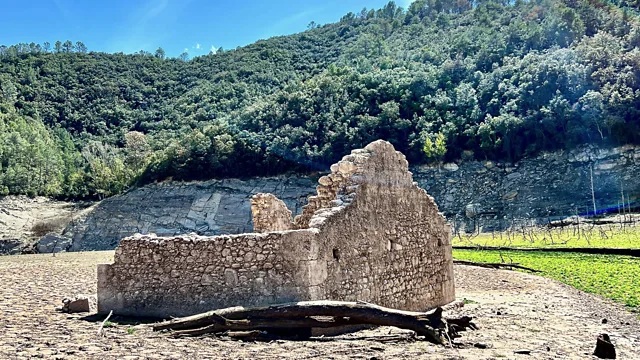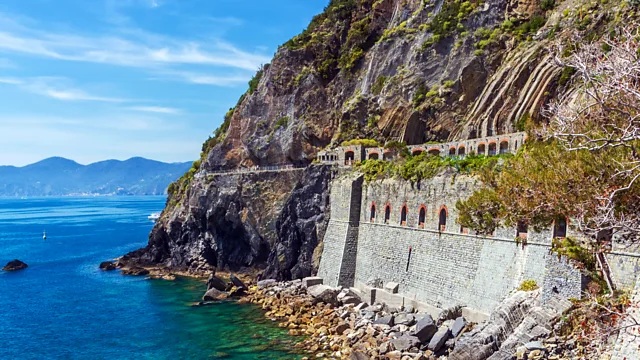
Mike MacEacheran
In the west of Scotland, above the crystal-clear waters of Loch Awe, is Ben Cruachan, the soaring remnant of some distant geological upheaval. The pine-skirted mountain is the highest point of a horseshoe of scalloped granite, spewed boulders and scree faces, and helps cradle Cruachan Dam, a mighty reservoir that offers a glorious panorama of the maze-like lochs and hills that make up mainland Argyll.
This landscape, with waters that run downhill and Atlantic salmon that leap up, is home to pine marten and golden eagle, osprey and rutting red deer. Often, Cruachan – “conical hill” in Scots Gaelic and Argyll’s highest mountain – is also the backdrop for hillwalkers wearing fluorescent waterproofs or mosquito repellent and mountain bikers bearing broad grins.
But most visitors come here for what can’t be seen.
For Ben Cruachan is a hollow mountain – a shell of quarried rock – and 325m beneath the dam’s towering buttress hides one of the most monumental engineering projects in Europe.
Behind colossal walls of solid granite is Cruachan Power Station, a subterranean world of machine halls, transmission lines and turbines with a capacity of 440 megawatts – or enough to power nearly 100,000 homes. It took a workforce of 4,000 to scoop out the insides of the mountain in the early 1960s and, by 1965, they’d helped create the first hydroelectric power station of its kind in the world. An aerial shot of Cruachan reveals no hint of this underground triumph.

Cruachan Power Station is a model for renewable and low-carbon energy production (Credit: Mike MacEacheran)
I first visited Cruachan Power Station some 35 years ago, aged seven, and I remember standing in awe, as if having walked into a colossal Hollywood production set. Down a 1.5km-long road blasted into the mountain, tours now take visitors into the very heart of this engineering temple – passing through a pitch-black entranceway and past dark corners and haunting tunnels that lead to control rooms in huge self-supporting caverns. This was where I was headed again, but in truth the story of Cruachan today begins only moments from the roadside, at one of the rare parts of the power station visible to the eye.
“There was never anything like this before,” said Sarah Cameron, manager of Cruachan Visitor Centre, where I began my latest trip underground. “And, nowadays, the biodiversity leading to the dam is extraordinary – butterflies, birds of prey, deer. It shows how nature can thrive alongside a project of this size. The power station has no visual impact. And no one knows it’s here.”
The power station has no visual impact. And no one knows it’s here
The centre lies tucked off the roadside, at the outflow to Loch Awe, occupying a modern building with an outlook over a trout farm. Inside, the museum shows the story of Cruachan to be a complex meld of science, technology and engineering, with displays bringing history to life and explaining how the world’s largest source of low-carbon energy (hydroelectric power) is generated.
Using four reversible turbines, the pumped storage hydro plant drives the loch water upwards, over millennia of strata, to fill the mountain reservoir when demand for electricity is low. This procedure recasts the power station as an immense battery, with the water stored for when it is needed. When demand surges, the stockpiled water is released and flushed through underground rotors to create power at rapid speed. When the network needs it, electricity can be triggered in as little as 28 seconds. By comparison, a traditional coal plant can take hours to spark to life. And the reservoir has a storage capacity of 10 million cubic metres — enough to meet the domestic water needs of the whole of Great Britain.

Cruachan Power Station has the capacity to generate power for nearly 100,000 homes (Credit: Mike MacEacheran)
“More than 2,000 Olympic-sized swimming pools can fit in the reservoir, so imagine how much energy can be created at the touch of a button,” explained Cameron, pointing up the hillside towards Cruachan Dam. “Yet many people cannot recognise the benefits because we’re hidden. To understand it, you need to know we’re delivering clean, green, efficient energy, which is more important than ever.”
When the clock struck the hour, a minibus appeared out of the security gate and we began our journey underground, like a rabbit vanishing into its hole. My own memories rushed back, the gentle slide into darkness awakening moments from an earlier life. And, moments later, along the concealed road, we arrived in another world entirely.
The engineers of the early 1960s were known as the Tunnel Tigers for their strong work ethic, and, over six years of construction, from 1959 to 1965, they hand-drilled and bored the rock, packed it with gelignite and detonated it. Working in the dark, they eventually removed more than 220,000 cubic metres of rubble, with one 18-year-old first-timer admitting the experience at the time was one of shock and awe. “The heat, the smoke – you couldn’t see your hands in front of you,” he said.
In total, 20km of tunnels and chambers were excavated, including the near-100m long, 36m-high machine hall. To add to that, one barrage, two dams, 13 aqueducts and three generating stations were built. Danger, too, was an ever present. Some 36 workers lost their lives.
It was an unsparing existence: toiling during exhausting 12-18 hour shifts, inhaling dense dust and smoke. Loose rocks as large as cars would often plummet from exposed walls, while the tunnel blasting made it seem as though Ben Cruachan was shaking above them. The gelignite had a smell that resulted in splitting headaches and burning eyes. “It was scary stuff,” another labourer said at the time. It was like they were waging war against the mountain.

Cruachan Power Station’s machine hall is high enough to house the Tower of London (Credit: Mike MacEacheran)
I entered the machine hall in the company of Colin MacFarlane, an electrical control and instrumental engineer involved in the day-to-day running of the station. We entered the cavernous machine hall – high enough to house the Tower of London and wide enough to fit Big Ben on its side – then stopped at the power-generating turbines, each of which weighs 650 tonnes.
“As engineering marvels go, it’s a knockout, isn’t it?” asked MacFarlane, as I stood in awe for the second time in my life. “All this machinery you can see is like an iceberg. This is only the tip, as most of it is hidden beneath our feet.”
As engineering marvels go, it’s a knockout, isn’t it
Later, we stopped at the base of a staircase in the power station’s cable shaft. With 1,420 steps, the staircase is the tallest in Britain. Around us, the air carried a soft transformer buzz.
At most of the world’s greenest power stations, the daily operations are rarely peaceful. Like Cruachan, many are open to tourists, with visitor centres demonstrating the benefits of green energy through tours, exhibitions and interactive walk arounds. Of the most impressive to see first hand are Snoqualmie Falls Hydroelectric Plant near Seattle, US (completed in 1899, it’s the world’s oldest underground power station) and Robert-Bourassa Generating Station in Quebec, Canada (with 16 turbines, it’s the world’s largest underground power station). Elsewhere in the UK, there are three other pumped storage hydro plants, with Dinorwig Power Station in Llanberis, Wales, hidden from sight inside Europe’s largest man-made cavern. Unfortunately, the visitor centre is currently closed.

Cruachan Dam is a mighty reservoir in Argyll (Credit: Monty Rakusen/Getty Images)
What these power stations all have in common is this: they’ve taken advantage of their landscape to provide long-term green energy. And they are doing so at a serendipitous moment, with demand at record levels and renewables like wind, solar and hydro power turning a new chapter in energy provision.
Currently, hydro power makes up 16% of the world’s electricity, accounting for more than 60% of renewable energy generation. Or as MacFarlane put it: “People see the potential for high-value green energy, so we’re the good guys. Plus, it’s exciting when engineering projects like ours come out of the ground, yet remain out of sight, out of mind.”
Yet Cruachan’s story does not stop here. Drax Group, the Yorkshire-based renewable energy company that owns Cruachan, has set the ambitious target of becoming one of the first companies in the world to run as carbon negative. Besides that, Cruachan 2.0 is in the pipeline, with plans to raise capacity to 1.04GW to reach its full renewable potential by 2030, and to help meet Scotland’s net zero targets by 2045. And, as potentially the first pumped storage hydro plant to be built in the UK for more than 40 years, Cruachan 2.0 will ensure there is no return to fossil fuels, regardless of demand and regardless of whether the wind is blowing or sun is shining.
And it looks like they’ll keep moving mountains to do it.
Courtesy: BBC
The post The mountain that helps power Britain appeared first on The Frontier Post.








